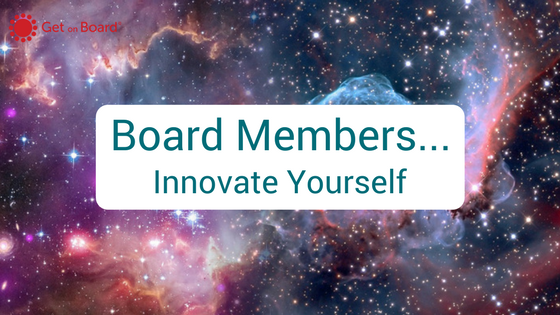Board Members… Innovate Yourself

Over the past couple of months I have written about the need for innovative and entrepreneurial thinking in the boardroom (here and here), and how you may be able to start incorporating this mindset into your board and organisation. There is one part of this conversation that remains largely un-talked about. And that is your mindset and perspective, and how this is shaped by the information you read, hear and watch, and the people you hang out with.
Is your world the real world?
In this day and age of algorithm-driven newsfeeds, the news and information you are receiving largely conforms with, and backs up, your view, perspective and opinion of the world. This does a lot to make you feel good and right and that your thinking is the same as everyone else’s thinking. But after a while you start to believe your own bulls**t. And you probably don’t even realise you’re doing that.
Add to that the television programs you watch, the websites you read, the people you follow on social media, the books you read, the radio programs you listen to, the people you hang out with, the people you share a board table with will usually be picked by you and will therefore conform to the same mindset and perspective as you. People do business with people they like and trust, and people like and trust people who are like them.
This phenomenon has a name. It’s called confirmation bias.
In a nutshell, you actively seek out information that confirms your existing beliefs, while discounting or ignoring information that disconfirms your beliefs. This happens without you realising it (which is, ironically, another bias in and of itself).
So how can you start to innovate within an organisation if you can’t first change your own thinking?
You as an individual board member must start innovating your own thinking before you can expect the rest of the board and an entire organisation to do so. Here are three easy steps that you can take to start innovating yourself.
1. Accept that your view is limited and biased
Most people think that all information sources are neutral and unbiased. They aren’t. People write the stories, and the way they write and how they choose to tell a story is influenced by their biases and in turn influences your perspective. Accept that you have preconceived notions and certain ways of thinking and these affect your decisions and actions.
For example, “all Gen-Yers just want instant gratification and have no people skills”. So your action is to not let them into the boardroom.
2. Start getting your information from varying (and opposing) sources
Begin with your daily news update. Instead of reading the same websites or newspapers, mix it up a little. You don’t have to agree with what you’re reading, just understand that there are many ways to interpret a situation. It’s hard and uncomfortable, but it’s worth doing.
For example, take a look at the US political coverage from CNN and Fox News. Yes, this happens in Australia too.
I also encourage you to start learning about fields and subjects beyond your profession and/or favoured topics. Reading fiction can also help your brain on many levels.
3. Don’t jump to conclusions
When being presented with something that “we tried before and it didn’t work” refrain from jumping to conclusions such as these. Think back to point number one above and seek to fully understand, rather than make hasty decisions or jump to conclusions.
This article gives you some questions to ask in real time to help you see how confirmation bias may be affecting you – and others – when listening or reading:
- Which parts did I (we) automatically agree with?
- Which parts did I (we) ignore or skim over without realizing?
- How did I (we) react to the points which I (we) agreed/disagreed with?
- Did this information confirm any ideas I (we) already had? Why?
- What if I (we) thought the opposite of those ideas?
For further reading, this post on bringing innovative thinking into the boardroom will give you additional ideas to reinvigorate your board’s collective mindset.
At the end of the day, the most considerable hurdle to bringing innovative and entrepreneurial thinking into the boardroom are the mindsets of the people sitting around the board table. Innovate your thinking before innovating the organisation.
How will you innovate your thinking?
